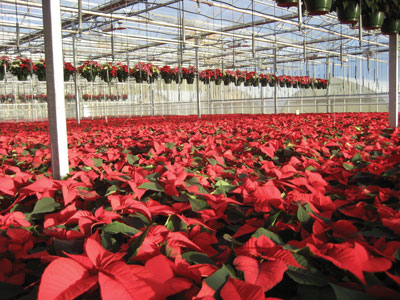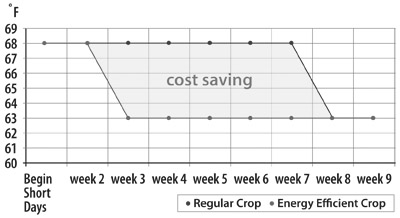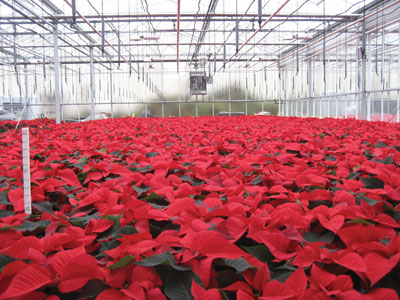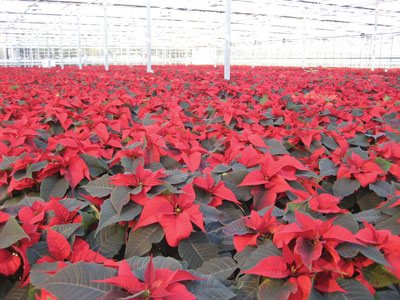
A successful energy-efficient and space-efficient poinsettia crop starts
with the variety selection, correct planning, quality young plant
material (rooted or unrooted), perfect planting conditions, and proper
pinching.
A successful energy-efficient and space-efficient poinsettia crop starts with the variety selection, correct planning, quality young plant material (rooted or unrooted), perfect planting conditions, and proper pinching.
 |
|
| Poinsettias remain a favourite crop in Canada – 6.9 million were grown in 2009. PHOTOS COURTESY STEFAN REINER Advertisement
|
A critical time is the vegetative crop period from planting until the beginning of short days (about two weeks into short days). This is the time a strong plant with proper height and a healthy root system needs to be built. Once you reach “week 3” of the short day (or generative) crop period, it is all about finishing and saving. If you shortcut the vegetative crop period, cost-savings and quality plants are more difficult to achieve. The general growing practices vary slightly between a regular and a cool crop using energy-efficient varieties like the Christmas Feelings series, ‘Christmas Eve,’ and the Christmas Carol series. The following recommendations will focus on the Christmas Feelings series and those differences (but can be applied to the above-listed varieties as well).
PLANNING
■ The Christmas Feelings series is a low-vigour series and requires more time to grow before entering short days. In addition, they don’t grow much after the beginning of short days and don’t stretch toward the end of the crop. Those are all good things but need to be considered during the planning process. Plant varieties in the Christmas Feelings series one to two weeks earlier compared to more vigorous varieties.
The extra time is necessary to ensure height and overall plant quality.
The accompanying chart compares the temperature curve between a traditional and an energy-efficient Christmas Feelings crop. Starting in week three after the beginning of short days, temperatures are much lower, reducing heating costs. The crop will be delayed by about one week, but the overall quality and shelf life will be improved. It’s also the period heating is most expensive.
 |
|
By growing energy-efficient and space-efficient varieties like those in the Christmas Feelings series, ‘Christmas Eve’ and Christmas Carol series, or similar offerings by other breeders, you not only reduce heating costs but also grow more plants per square foot, reducing your cost per plant even further. They are low-maintenance with little or no shrink, helping to maximize cost efficiency. It is the cost per plant that counts and not per square feet/metre. Looking at it this way will eliminate many energy-efficient varieties because of their high space requirements, shrink and higher maintenance.
VEGETATIVE PERIOD
■ Don’t try to reduce costs during the wrong time. Energy-efficient varieties, such as Christmas Feelings, are not intended to be grown cool from planting on. During the first weeks, until the beginning of short days, you need to keep the temperature up. Night temperatures are especially important, as heating may be necessary during cold nights in August and September. Recommended temperatures during the vegetative growing period are 68 to 73°F day and 68°F night.
Depending on the location of your greenhouse and the general condition, cool-morning drops can be applied to control growth. Drop temperature by 8 to 10°F two hours before sunrise until about two to three hours after sunrise. Keep the average temperature in mind to avoid stunting, and watch for the dew point. Don’t use cool morning temperatures if side shoots look uneven. Keep the temperature up in the morning until the plants even out. When humidity is a problem, negative DIF with 68°F night and 65°F day has proven to be the better choice. Additional PGR treatments may become necessary, but remember that varieties in the Christmas Feelings series are low-vigour varieties so fewer applications with lower concentrations are recommended. General good growing practices should be applied to reach a strong plant quality when entering the generative crop period.
GENERATIVE PERIOD
■ This is the time to reduce costs by turning down the heat. About two to three weeks into short days (depending on the crop and location of your greenhouse), slowly lower the temperatures to the recommended minimum temperatures for the energy-efficient variety you grow. For example, Christmas Feelings can be finished with 66° to 73°F day and 62°F night. You can continue to use cool-morning drops or negative DIF for height control until the end of “week 4” of short days; just keep in mind that Christmas Feelings, for example, needs a minimum average day temperature of 63°F. Keep in mind also that with such temperatures the plant won’t grow much anymore, and that explains why the vegetative crop period is so important. You need to enter the final phase with strong, healthy and good-sized plants. Heating is not expensive during summer and early fall but will become more expensive starting mid-October, so build the plant when it’s cost effective and save when it’s not.
THE FINISHING PHASE
■ To ensure quality and cost savings, you will need to watch a couple of important points during the low-temperature finishing phase. In general, a cooler grown crop will finish a couple days later, and will have smaller bracts, and darker colours (whites may turn cream-yellow). If you grow the crop cooler as recommended, the crop might be further delayed and bracts underdeveloped. However, Christmas Feelings gives you the option to balance cooler night temperatures with higher day temperatures. So if you have a nice bright fall and are able to keep the day temperature up, you can further lower the night temperature (min. 57°F) without delaying the crop. Just keep the needed minimum average day temperature in mind and don’t undercut it.
  |
|
| These images show a six-inch Christmas Feelings crop in week 46 (natural day) in the greater Vancouver, B.C., area. The crop in the larger image was finished “cool” and the crop in the smaller image “traditional.” The plants above are sturdier and about five days behind the crop on the right.
|
Keep the humidity in mind as well, and if possible, stay below 75 per cent. Keep air circulating! Regular air exchange will help you to avoid botrytis and powdery mildew problems. Space plants accordingly to help keep humidity lower. Avoid dropping the temperature below the dew point (especially in humid areas)!
Use the correct light levels whenever nature provides it. Especially in northern regions, wash the roof if necessary. In southern regions, shading may be necessary. Recommended light levels are 3,500 to 4,500 foot-candles from a week after pinching until mid-October, 3,000 foot-candles until two weeks before shipping, and 2,000 to 2,500 foot-candles for the last two weeks. Observe light level recommendations for propagation, planting, pinching and spacing, as those are periods when poinsettias require less light!
When planning on growing an energy-efficient crop, avoid mixing energy-efficient varieties with regular varieties. You can grow energy-efficient varieties warmer, but it won’t work the other way around. Know your varieties and consider all aspects during the planning process.
Stefan Reiner is a product management and tech support specialist with Selecta First Class. • s.reiner@firstclassplants.com
Print this page